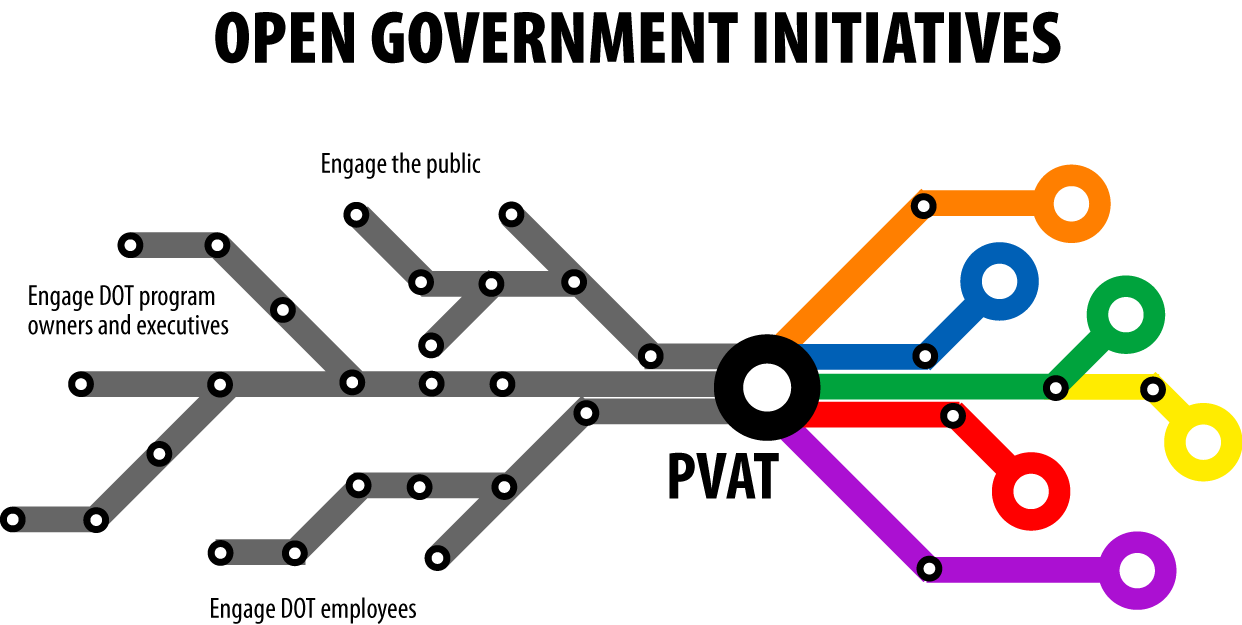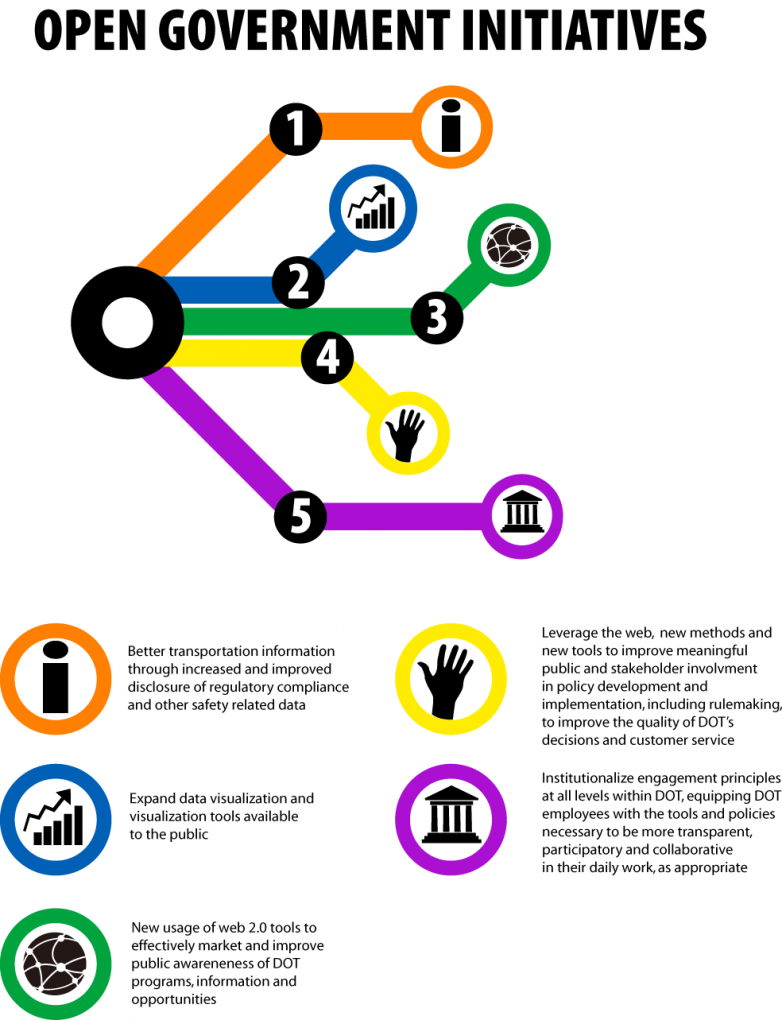Open Government Plan - Chapter 2
Developing DOT’s 2nd Open Goverment Plan
DOT took a different planning approach for the 2012 Plan than we did for the 2010 Plan. In 2010, the Department had many policy, cultural and technology barriers to overcome to lay the groundwork for increasing transparency, participation and collaboration in our daily work as described in the Open Government Directive. DOT developed a framework (see Figure 3) that helped us comprehensively analyze and address those barriers. From 2010-2012 DOT made significant progress towards laying the groundwork for openness. Consequently, for the 2012 Plan, we decided to leverage that groundwork and focus our planning efforts on specific, new initiatives and the public value they would create.
The process we used to develop the 2012 Plan, which was focused on looking at the public value of our Open Government related activities, is illustrated by Figure 4. To do this, we used a planning approach called the Public Value Assessment Tool (PVAT), created by the Center for Technology in Government (CTG) at the University at Albany, SUNY. While the concept of public value is not new and DOT has invoked value analysis as part of its decisionmaking processes, the PVAT represented a new opportunity to systematically assess the public value of DOT’s Open Government efforts. DOT sought ideas from multiple sources for activities to include in the Plan that would align with the goals of Open Government. Ultimately, these activities were grouped into similar categories, and prioritized to select our flagship initiative for 2012-2014. The following section will describe in more detail how ideas for activities were sought, how activities were assessed for public value, and how our flagship initiative was selected.

Section 2.1: Seeking Ideas for Open Government Activities
The following section describes how ideas for activities to include in the Plan were sought from three primary sources:
- DOT employees as a whole
- DOT stakeholders and the general public
- DOT program managers and executives
Section 2.1.1: Engaging DOT Employees

To adhere to the principles of transparency, participation, and collaboration with almost 60,000 DOT employees from across the country in this planning process, DOT used two collaboration platforms to engage directly with employees:
- DOT’s IdeaHub platform, a DOT-wide ideation platform launched after publication of the first Open Government Plan
- DOT’s intranet
- The Open Government sites were set up to allow transparency into the Open Government team’s mission, goals, discussions, and work, but restricted day-to-day collaboration and document editing only to team members
- Document libraries were created to store and display the team’s final work products for all DOT employees to see.
Section 2.1.2: Engaging the Public
The process used to engage the public in the planning process is illustrated by Figure 6 below.

Recognizing that many great ideas do not come from within our own walls, DOT also sought ideas from our stakeholders and the general public, in adherence with the Open Government Directive. To do this, DOT leveraged IdeaScale, an online public dialogue platform, to ask for the public’s ideas for activities to include in the Open Government Plan. Specifically, DOT used IdeaScale to solicit ideas on:
- New approaches and technologies that would enable DOT to be more open, efficient and save taxpayer money
- Additional information and high-value data we could provide to be more accountable, improve knowledge of our policies and programs, and create economic opportunity
- Specific opportunities to further encourage two-way conversations with stakeholders and members of the public to share ideas and expertise to improve our policies and programs
To promote this dialogue, we leveraged the @raylahood Twitter channel as well as our formal stakeholder networks. We received a total of seven ideas. Most of those ideas focused on issues individuals with disabilities confront in transportation, and on industry collaboration ideas.
DOT’s use of the IdeaScale citizen engagement tool was an excellent opportunity to employ the Open Government principles of transparency and collaboration during the development of our Open Government Plan. As detailed in Chapter 3, DOT is actively pursuing using online engagement tools to solicit public feedback during the development other DOT plans, such as DOT and Operating Administration (OA) level strategic plans.
Section 2.1.3: Engaging DOT Program Owners and Executives
The process used to engage DOT program owners and executives in the planning process is illustrated by Figure 7 below.

Since 2010, the DOT Open Government team has actively supported an Open Government Executive Steering Group (OGESG). This group of executives and champions from across the Department has acted as the primary advisory body to the Deputy Secretary on all initiatives relating to Open Government. Membership spans all disciplinary fields (e.g., policy, legal, business, technical) and operating administrations (FAA, FTA, OST, etc.). Executive sponsorship from across the Department helped sustain agency-wide attention to Open Government activities throughout the planning period. This group was actively involved in the crafting of the second Plan and met several times to discuss the approach, review progress and share recommendations with the Open Government team.
In addition to engaging the OGESG, DOT went through an extensive process internally to identify potential activities with high public value to include in the Plan. The Open Government team met one-on-one with program owners from across DOT to identify future activities aligned with Open Government principles and brainstorm about new activities that would both further program goals and leverage the benefits Open Government approaches can provide. Over 20 activities were identified through this method of engagement.
Section 2.2: Assessing Proposed Activities and Selecting a Flagship Initiative
All of the ideas collected through the public engagement, employee engagement and program office engagement activities were considered for inclusion in the Plan. Of the nearly 50 concrete ideas that were submitted, almost half were advanced to the assessment phase. This was based largely on whether a logical program owner for the idea could be identified. Those activities that made it to the assessment phase were run through the PVAT process to better understand the potential public value. Once the individual project assessments were complete, like activities were grouped into initiatives, and flagship initiative candidates were selected. The information from the PVAT analysis was one of several pieces of information that went into decisionmaking. The following sections describe the entire process in more detail.
Section 2.2.1: The Public Value Assessment Tool (PVAT)
DOT leveraged individual PVAT assessments to create a portfolio view of DOT’s Open Government Plan. The Center for Technology and Government (CTG) at the University at Albany, SUNY created the PVAT to support government agencies in decisionmaking and planning in order to develop public value-rich Open Government plans. The PVAT takes agencies through a process designed to answer the question, “Does our Open Government program, taken as a whole, optimize resources and capabilities, while meeting our mission and delivering maximum public value to our stakeholders?” In applying the tool, CTG worked with DOT in a group planning process designed to examine each proposed initiative being considered as part of an the DOT Open Government portfolio. Each proposed initiative was considered from a stakeholder and public value perspective. This new understanding of each initiative was then used to inform decisions about the elements of our overall Open Government portfolio and Plan.
Using the PVAT process, DOT developed both in-depth qualitative public value statements and overall activity summary judgments—both of which are essential inputs to overall agency decisionmaking for Open Government planning. The PVAT process was then used to help describe the value of the set of activities considered for inclusion in DOT’s Open Government Plan, as a portfolio. The PVAT process played a role in helping to frame the priorities of the Plan and the value of those initiatives to the public.
Section 2.2.2: Grouping Activities into Initiatives
The PVAT analysis also helped DOT group like activities into broader categories of initiatives that align with DOT’s Open Government and public engagement goals. Thirteen specific activities were grouped into five high level initiatives that are described in the Figure 8 and Table 3, below. Chapter 3 will describe each of these activities in detail and share the public value insights gained through the PVAT process.

|
DOT Open Gov Goal |
Initiative |
Activity |
|---|---|---|
|
1: Increase Agency Transparency and Accountability |
1: Better transportation information through increased and improved disclosure of regulatory compliance and other safety related data |
Safety.data.gov
|
|
PHMSA Regulatory Enforcement and Compliance Data Interoperability
|
||
|
Regulatory Enforcement and Compliance Plan
|
||
|
2: Expand data visualizations and tools available to the public |
visualDOT
|
|
|
3: New usage of Web 2.0 tools to effectively market and improve public awareness of DOT programs, information and opportunities |
New Social Media Tools
|
|
|
TIGER Web site
|
||
|
2: Apply Citizen Knowledge through Participation to Government Service |
4: Leverage the Web, new methods and new tools to improve meaningful public and stakeholder involvement in policy development and implementation, including rulemaking, to improve the quality of DOT’s decisions and customer service |
Digital Transportation Exchange
|
|
Open Transit Data
|
||
|
Automation of Commenting on DOT Rulemaking
|
||
|
Veterans Transportation and Community Living Initiative Collaborative Planning Tools for Transportation Planning
|
||
|
3: Institutionalize an Open DOT Culture |
5: Institutionalize engagement principles at all levels within DOT, equipping DOT employees with the tools and policies necessary to be more transparent, participatory and collaborative in their daily work, as appropriate. |
IdeaHub
|
|
Strengthen Public Engagement
|
||
|
Collaborative Tools
|
Section 2.2.3: Selecting a Flagship Initiative
Once the PVAT process was conducted, the next challenge for DOT was to select a flagship initiative from the list of activities described in Table 3. The information generated through the PVAT process was important to consider when selecting the flagship, but it was not the only factor. In addition, the OGESG developed a list of other factors that would be important to have demonstrated by a flagship initiative. These included:
- DOT strategic goal alignment
- Cross-modal in scope
- Ability to be completed within existing program resources
- Identified in response to stakeholder demand (i.e. FOIA requests, external idea, etc.)
- Total economic value (as determined by the PVAT process)
- Total stewardship value (as determined by the PVAT process)
These factors were characterized for every activity evaluated through the PVAT process and one initiative floated to the top, as illustrated by Figure 9, below:

Thus safety.data.gov was recommended to DOT leadership and was selected to be DOT’s Open Government flagship initiative for 2012-2014.
The final Plan was routed for DOT-wide review and comment before being published on www.dot.gov/open.


